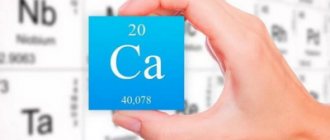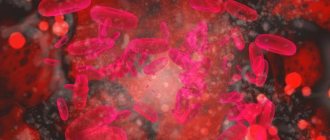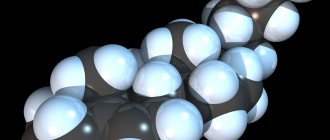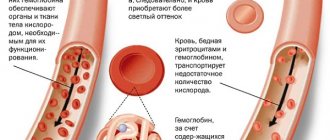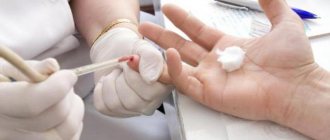Blood is an extremely complex tissue of the human body, which contains, in addition to its components (red blood cells, leukocytes, platelets, etc.), also various inorganic and organic compounds (oxygen, iron, cholesterol and many others). Such a diverse composition of blood is necessary for normal metabolism, which ensures the vital functions of the body.
Among the substances contained in the blood, cholesterol in the blood plays one of the most important roles, since this compound, on the one hand, is involved in many important physiological processes and, on the other hand, an excess of total cholesterol or some of its varieties, called fractions, can have a significant negative effect on many aspects of health.
The role of cholesterol in the body
From a chemical point of view, cholesterol (C27H46O) is a fatty alcohol. It is absolutely necessary for the body to successfully perform several functions at once:
- formation of sufficiently strong cell membranes
- production of various hormones (primarily sex hormones)
- normal functioning of the nervous and immune systems
- vitamin D synthesis
- synthesis of bile acids, which play an important role in food digestion
Cholesterol is insoluble in water, which forms the basis of blood, and therefore complex cholesterol compounds with special transporter proteins are used to deliver it to body tissues.
4/5 of all cholesterol in the body (and this substance is found not only in the blood, but also in many other fluids and tissues) is produced by the body itself, and 1/5 comes from food.
Due to such an important role of cholesterol, a blood test, which allows you to determine both the concentration of total cholesterol in the plasma and the level of its individual varieties (fractions), is of great informative value for a doctor when diagnosing various diseases.
However, in order to obtain reliable data from such an analysis, the patient should prepare for it in a certain way - otherwise the results will either be significantly distorted, or the analysis will become completely impossible...
What is the essence of this blood condition?
Blood is called fatty or chylous when it contains triglycerides in a concentration much higher than the permissible limit. In this case, the blood plasma, after separation by centrifugation, has a rather thick consistency and a whitish color. Few laboratories are able to continue laboratory diagnostics with such material.
Triglycerides are neutral lipid compounds that form the basis for meeting the energy needs of all cells. They enter the body with plant and animal foods. Their absorption occurs thanks to the villi of the small intestine, then they enter the blood, where they are transported to tissues in the form of chylomicrons.
Normal blood triglyceride values vary depending on a person's gender and age. The average normal level of blood triglycerides, according to WHO, is considered to be a concentration of up to 1.17 mmol/l. Exceeding their permissible norm leads to an imbalance in the lipid balance of the body. This condition is called dyslipidemia or hyperlipidemia.
"Fat Blood"
In some cases, having received the test results in your hands, you can hear a frightening phrase from a medical laboratory employee: “The analysis could not be done: your blood is too oily...”. At the same time, the form contains the even less understandable phrase “chylous serum” or “chylosis” - and the figures for the indicators are, as a rule, absent.
However, the mysterious record of chyle should not at all become a reason for despair. In most cases, it indicates that there were too many triglycerides in the blood when testing the sample, which made it impossible to separate it into fractions using centrifugation.
Triglycerides, along with cholesterol, are one of the forms of fat in the human body - it needs them to increase the strength of cell membranes, as well as to create energy reserves in the form of fat deposits.
The concentration of triglycerides in the blood can fluctuate significantly during the day - for example, eating even a small amount of food leads to a sharp jump in this indicator, and the increased level of triglycerides after eating a sandwich can persist for more than half a day.
Thus, the gloomy term “fat blood” in many cases hides the result of a simple failure to comply with the rules of preparing for a cholesterol test.
However, it should be noted that chylosis can also occur in fairly severe conditions associated with certain diseases. In such cases, the level of triglycerides goes through the roof even with proper preparation for donating blood. Such diseases include:
- obesity
- diabetes
- some thyroid pathologies
Often the cause of “fat blood” can also be:
- chronic kidney disease (especially kidney failure)
- liver diseases (chronic forms of viral hepatitis, cirrhosis of this organ)
- vascular and heart diseases (cerebral vascular thrombosis, atherosclerosis, hypertension)
- joint diseases (arthritis, polyarthritis, gout)
- pancreatic diseases (primarily acute and chronic pancreatitis)
- chronic stress
Finally, in very rare cases, high levels of triglycerides (“fat blood”) are observed with lipid metabolism disorders associated with heredity. This phenomenon is usually observed among members of the same family and can be passed on from generation to generation.
Fatty blood: what does it mean and what to do in such cases – About convictions
We know well that it is necessary to prevent cardiovascular diseases, strengthen the heart muscle, and very often we do not pay attention to the condition of our blood. But the state of the entire cardiovascular system, and ultimately the health of the entire organism, largely depends on the state of the blood.
Blood is the main living medium, on the quality of which all processes occurring in organs and cells depend.
Blood consists of two parts: plasma (the liquid part) and the formed elements suspended in it (erythrocytes, leukocytes and platelets).
The main function of blood is the transport function. It involves the blood transporting respiratory gases (oxygen and carbon dioxide), hormones, minerals and many other substances to organs and tissues.
If the quality of blood is impaired, primarily thickening, acidification, increased cholesterol, blood sugar, etc., its transport function is hampered, which leads to disruption of redox processes throughout the body, including the heart, brain, liver, kidneys and etc. This is why it is so important to maintain blood quality within optimal homeostasis.
Causes of blood thickening
Thick blood means that its viscosity is increased. The thickness of the blood is influenced by a number of factors. This is damage to the walls of blood vessels, dysfunction of the liver, leading to deviations in the chemical composition and increased viscosity of the plasma, a change in the state of the cell membranes of red blood cells and platelets, which leads to their aggregation (increased clumping of these cells).
The cause may be an excess amount of red blood cells, hemoglobin or platelets, which leads to an imbalance in the ratio of cell mass and the liquid part of the blood.
Acidification of the body, irradiation, deficiency of vitamins and minerals that are involved in the production of hormones and enzymes, hyperfunction of the spleen, which plays a large role in the process of hematopoiesis, and the presence of parasites in the body also lead to blood thickening.
Very often, the main cause of thick blood is a lack of water in the body. If the body does not have enough water for its vital functions, it extracts it from the blood, which leads to a decrease in the mass of the liquid part of the blood and it becomes more viscous.
Diabetes, drinking alcohol, smoking, hypothermia and even stress can lead to blood thickening.
How does a person feel if his blood is thick?
Increased blood viscosity does not have any characteristic symptoms. Blood thickening is often accompanied by general weakness, drowsiness, headache, memory loss, confusion, fatigue, and depression. Many people experience dry mouth and increased blood pressure. Venous nodules may appear on the legs, and the extremities are constantly cold.
Such symptoms can occur in many other diseases, and we rarely associate our poor health with the presence of thick blood.
Sometimes there are no symptoms at all and hypercoagulation is discovered by chance during blood tests. This is why annual physical examinations are so important.
How can you confirm your fears that your blood is thick?
In order to determine whether your blood is really thick, you need to take the following tests: a general blood test, a test for blood clotting and bleeding duration, a coagulogram, hematocrit (the sum of all blood elements - red blood cells, white blood cells, platelets, in relation to the total blood volume ).
Why is thick blood dangerous?
Thick blood leads to slower blood flow, which leads to oxygen starvation and disruption of organ trophism. The most dangerous consequence of increased blood viscosity is the formation of blood clots.
If you do not pay attention to the symptoms in time and do not eliminate the causes of blood thickening, very unpleasant consequences can occur.
Thick blood can cause hypertension, heart failure, atherosclerosis, thrombosis, heart attack and stroke.
More often, thick blood occurs, of course, in older people, but there is a tendency to increase the number of young and middle-aged people with this pathology.
Increased blood viscosity is more common in men than in women. The risk of myocardial infarction is very high in young men with an increased number of red blood cells and hemoglobin who do not pay attention to their health.
But by eliminating the causes of blood thickening, they could avoid it.
What to do if you have thick blood
To solve the problem of thick blood, doctors usually prescribe Aspirin (1/4 tablet per day) and other drugs based on it (Aspirin-cardio, Cardiopyrin, Cardiomagnyl, ThromboASS), as well as Coumadin (Warfarin).
I want to tell you about the prevention of blood thickening and treatment with folk remedies .
Drink more water!
Many people drink very little pure water, replacing it with tea, coffee, and sweet soda. An adult should drink 2 - 2.5 liters of liquid per day, of which at least 1 liter should be clean water. Even more so in hot weather. Teach your children to drink water. Natural water is a very powerful remedy against blood thickening and blood clots.
Follow a diet for thick blood
If you have thick blood, you need to watch your diet. Eliminate fatty and fried foods, smoked foods, canned foods and marinades from your diet. Sugar and any other sweets are not recommended.
Blood thickening products should be limited. Here is a list of them: meat broths, fatty meats, sausages, jellied meat, bananas, mangoes, cabbage, cream, white bread, chokeberries, viburnum, lentils, grape juice, rose hips, buckwheat.
But don’t be upset, there are a lot of delicious foods that, on the contrary, will help thin the blood.
Products that help thin the blood : garlic, beets, ginger, blueberries, raspberries, strawberries, apples, cherries, plums, lemon, orange, grapefruit, pomegranate, cucumbers, zucchini, tomatoes, red bell pepper, artichoke, sprouted wheat grains, sea fish , cocoa, dark chocolate, sunflower seeds.
To thin the blood, products containing the amino acid taurine are recommended. Most taurine is found in seafood (fish, shellfish, shrimp, etc.).
These products must be consumed at least 2 – 3 times a week. Please note that when cooked, the amount of taurine in food is significantly reduced.
Therefore, to obtain the required dose, you should take high-quality dietary supplements with taurine.
Eat seaweed regularly. Dry seaweed can be ground in a coffee grinder and eaten instead of regular salt.
An additional source of Omega-3 unsaturated fatty acids is flaxseed oil, which can be taken one tablespoon per day. Prostaglandins synthesized from these acids lower cholesterol levels and thin the blood. Olive oil (unrefined, cold pressed) has the same properties.
Walnut increases blood viscosity, but in combination with other herbs it is used in the treatment of atherosclerosis, varicose veins, consequences of stroke, etc. The same applies to Sophora japonica.
Large amounts of salt increase blood viscosity.
Physical activity
Don't forget about physical activity. To maintain a healthy circulatory system, you need to move. This could be running, swimming, fitness, dancing, yoga - any sport that suits your taste.
Running is the simplest and most accessible of them. Many people think that you need to run in the morning, but this is not true. In the morning, blood viscosity is increased and it is difficult for the heart to push it through the vessels, even without a load. It is better to run in the evenings, and in the morning you can do a light warm-up.
Quit smoking and alcohol
They significantly increase blood viscosity.
Attention! Diuretics, hormonal and contraceptive drugs, as well as Viagra, thicken the blood.
Medicinal herbs that thicken blood
These herbs include: plantain, shepherd's purse, knotweed, tansy, valerian, horsetail, St. John's wort, burnet, corn silk, nettle (fresh leaves). Herbs should be taken in courses and in no case constantly.
Medicinal herbs that thin the blood
To thin the blood in folk medicine, the following are used: wormwood, chicory, lungwort, meadowsweet, peony, hawthorn, lemon balm, red clover, ginkgo biloba, Caucasian dioscorea, willow bark, mulberry, acacia, sweet clover, horse chestnut (but only its peel, the chestnut fruits are very poisonous), aloe juice and Kalanchoe.
Traditional medicine recipes for thick blood
In folk medicine, there are many effective remedies that can replace Aspirin. I will share some of them with you.
Meadowsweet (meadowsweet).
1 tbsp. Pour a spoonful of meadowsweet into one glass of boiling water and leave for 30 minutes. Strain and drink like tea. Meadowsweet decoction is indicated for various problems with the blood and vascular system, and tumors. It improves memory, cleanses blood vessels, and has a sedative effect. Can replace Aspirin.
Horse chestnut.
Crush the horse chestnut fruits with a hammer and collect the brown peel. Throw away the fruits themselves (they are poisonous), and pour 50 g of the peel into 0.5 liters of vodka. Leave for 2 weeks in a dark place, then strain. Take one teaspoon 2-3 times a day, mixed with ¼ glass of warm water. Drink on an empty stomach. You can eat no earlier than 30 minutes after taking the tincture.
Nutmeg.
Grind the nutmeg. Pour 100 g of nutmeg into 0.5 liters of vodka. Leave in a dark place for 2 - 3 weeks, then strain. Drink 20 - 30 drops per ¼ glass of warm water, 3 times a day 30 minutes before meals.
Garlic, honey and lemon.
1/3 jar of finely chopped garlic and 2/3 vodka. Bank of any size. Infuse for 2 weeks in a dark place, shaking once every 2-3 days, then strain. Add honey and freshly squeezed lemon juice to the tincture in a 1:1:1 ratio. To stir thoroughly. Take one tablespoon 1 time per day before bed. Store in a cool, dark place.
Dietary supplements (BAA)
I recommend that my patients take dietary supplements containing dihydroquercetin. Here are some of them:
- Flavit – dihydroquercetin powder (obtained from the wood of Siberian larch and Dahurian larch). For prevention, take one capsule per day.
- Dihydroquercetin is made from the same raw materials. Take one tablet once a day.
- Capilar is the same raw material. Reduces blood viscosity. Take 1 - 2 tablets 3 times a day.
To prevent blood thickening, these drugs are used in courses of 3 weeks. The break between courses is 7 – 10 days.
Hirudotherapy for blood thickening
The most effective method of traditional medicine in the fight against high blood viscosity is hirudotherapy (treatment with leeches). Leeches, by injecting saliva containing many different enzymes (including hirudin), can significantly improve the properties of blood and reduce its viscosity.
Source:
What is blood chyle and how to prevent it
The first reason for the appearance of chylous blood is incorrect testing. Everyone knows that blood must be donated on an empty stomach, and the day before it is not recommended to consume fatty foods and alcohol.
After eating, there is a temporary increase in the level of fats and glucose in the blood, and after drinking alcohol, liver enzymes increase.
The duration of the period during which the blood will be oily is determined by the individual characteristics of the body and the quality of food eaten.
Another cause of chylous blood is metabolic disorders. Often all family members have elevated cholesterol levels.
This is due not only to dietary habits, but also to a hereditary factor (hereditary hypercholesterolemia).
Some liver diseases can also lead to oily blood. This process is aggravated by poor nutrition.
Causes
Sometimes blood chylosis is not a symptom of pathology. For example, such a result can be obtained by violating the rules of donating blood. To have reliable data, it is necessary:
- do not eat foods containing fats or alcohol the day before the test - in the first case, the level of lipids and sugar in the blood increases, in the second - liver enzymes;
- Do not eat 10–12 hours before giving your blood sample.
In other cases, the presence of triglycerides in the blood may be a consequence of:
- inherited metabolic disorders, including lipid metabolism;
- metabolic diseases: diabetes, obesity, anorexia;
- diseases of the digestive system: viral hepatitis, cirrhosis, chronic and acute pancreatitis;
- cardiovascular diseases: hypertension, atherosclerosis, myocardial infarction, angina pectoris;
- bleeding disorders;
- pathologies of the musculoskeletal system: gout, polyarthritis, arthritis;
- lifestyle: unhealthy diet, alcoholism, stress;
- disorders of the lymphatic system;
- respiratory distress syndrome;
- renal failure;
- hypothyroidism;
- hypercalcemia;
- Down syndrome;
- taking certain medications, for example, hormonal drugs, diuretics, beta blockers.
Source: https://med-lk.ru/krov-i-krovotecheniya/zhirnaya-krov-chto-eto-znachit-i-chto-delat-v-takih-sluchayah.html
Blood test for cholesterol: how to prepare
You should consult your doctor or one of the independent laboratories in advance about how to properly prepare for donating blood for cholesterol and its fractions.
To obtain the most reliable results of a blood test for cholesterol, you should donate blood from a vein on an empty stomach in the morning. In this case, the duration of abstinence from food should be at least 8 hours. It is also recommended to refrain from eating too fatty foods for 2-3 days before taking the test.
Treatment methods for blood chylosis
Treatment of chylosis depends on the reasons for it. If the analysis turns out to be unsatisfactory due to the presence of too many neutral fats in the blood, the patient is first sent for a repeat blood donation. At the same time, he is required to carefully follow all recommendations:
- Blood is drawn on an empty stomach (even a light breakfast is not allowed);
- Before taking the test, the blood must be clear of various additional impurities (especially alcohol).
In cases where chylosis is again detected during a repeat analysis, the patient is sent to the attending physician for consultation and to receive instructions regarding the elimination of manifestations of chylosis.
The main requirement for chyle is to follow a special diet, which involves excluding from the diet:
- Fatty foods;
- Fried foods;
- Flour products;
- Pickles;
- Spicy seasonings;
- Sauces;
- All types of alcohol.
With chylosis, drinking plenty of fluids is indicated. It is better to make a choice in favor of ordinary drinking water (pure or with the addition of lemon juice) or still mineral water.
The doctor may then resort to treating the chylosis with medication. Drug therapy is selected in each specific case based on the individual characteristics of the patient’s body and the presence of concomitant diseases. Its main goal is to eliminate the likelihood of developing any complications and prevent the progression of pathology. As a rule, drugs are prescribed that help normalize liver function and improve metabolic processes in the body.
Blood cholesterol level
Blood cholesterol levels are measured in millimoles per liter of blood. In the form with test results, the abbreviation mmol/l is placed after the number. To measure the concentration of cholesterol and its fractions, different methods are used - both direct and indirect biochemical, as well as more complex enzymatic ones, which involve the use of various reagents (catalase, cholesterol esterase, peroxidase). Currently, enzymatic analysis methods are used in most laboratories.
There are even more accurate (and therefore more expensive) methods for determining blood cholesterol levels using liquid and gas-liquid chromatography.
Blood cholesterol level is normal
There is no single indicator of the normal level of total cholesterol for all people, as is the case, for example, with blood pressure, pulse rate or visual acuity. The difference in indicators is due to the metabolic characteristics of children and adults, as well as the gender of the patient.
- for newborns, a cholesterol level of 1.37-3.5 mmol/l is considered normal
- for children in the first year of life, the normal value is 1.81-4.53 mmol/l
- in childhood (1 year-12 years) it is 3.11-5.18 mmol/l
- in adolescence (13-17 years) – 3.11-5.44 mmol/l
- in adults, the normal range is noticeably wider and ranges from 3.63 to 6.2 mmol/l
Blood cholesterol level is normal for women
The normal level of cholesterol in the blood for women of reproductive age is the same as for men of the same age. In women before the onset of menopause, total cholesterol levels should be stable - only after the onset of menopause is their increase observed. This is primarily due to specific changes in hormonal levels in the fair sex.
Blood cholesterol level
| Cholesterol norm table | |
| optimal | below 5.2 mmol/l |
| maximum permissible | 5.2-6.2 mmol/l |
| high | above 6.2 mmol/l |
Normal blood cholesterol levels in women
The level of cholesterol in the blood of women is also very closely related to their menstrual cycle. During the first half of the cycle, fluctuations from the average normal value can be 9-10% - however, this phenomenon is considered not a pathology, but a physiological norm. In the second half of the cycle, total cholesterol levels may increase by 7-8%. This phenomenon is associated with the influence of female sex hormones on the formation of cholesterol in the body.
And the basic indicators of the normal concentration of total cholesterol in women are:
- from 3.6 to 5.2 mmol/l – norm:
- from 5.2 to 6.19 mmol/l – moderately elevated
- over 6.19 mmol/l – significantly increased
Blood cholesterol levels in women table
| Age | Total cholesterol |
| less than 5 years | 2.90-5.18 mmol/l |
| 5-10 years | 2.26-5.30 mmol/l |
| 10-15 years | 3.21-5.20 mmol/l |
| 15-20 years | 3.08-5.18 mmol/l |
| 20-25 years | 3.16-5.59 mmol/l |
| 25-30 years | 3.32-5.75 mmol/l |
| 30-35 years | 3.37-5.96 mmol/l |
| 35-40 years | 3.63-6.27 mmol/l |
| 40-45 years | 3.81-6.53 mmol/l |
| 45-50 years | 3.94-6.86 mmol/l |
| 50-55 years | 4.20-7.38 mmol/l |
| 55-60 years | 4.45-7.77 mmol/l |
| 60-65 years | 4.45-7.69 mmol/l |
| 65-70 years | 4.43-7.85 mmol/l |
| over 70 years old | 4.48-7.25 mmol/l |
Table of blood cholesterol levels by age
| Age | Floor | Total cholesterol level |
| under 5 years old | man | 2,95-5,25 |
| woman | 2,90-5,18 | |
| 5-10 years | man | 3,13-5,25 |
| woman | 2,26-5,30 | |
| 10-15 years | man | 3,08-5,23 |
| woman | 3,21-5,20 | |
| 15-20 years | man | 2,93-5,10 |
| woman | 3,08-5,18 | |
| 20-25 years | man | 3,16-5,59 |
| woman | 3,16-5,59 | |
| 25-30 years | man | 3,44-6,32 |
| woman | 3,32-5,75 | |
| 30-35 years | man | 3,57-6,58 |
| woman | 3,37-5,96 | |
| 35-40 years | man | 3,78-6,99 |
| woman | 3,63-6,27 | |
| 40-45 years | man | 3,91-6,94 |
| woman | 3,81-6,53 | |
| 45-50 years | man | 4,09-7,15 |
| woman | 3,94-6,86 | |
| 50-55 years | man | 4,09-7,17 |
| woman | 4,20-7,38 | |
| 55-60 years | man | 4,04-7,15 |
| woman | 4,45-7,77 | |
| 60-65 years | man | 4,12-7,15 |
| woman | 4,45-7,69 | |
| 65-70 years | man | 4,09-7,10 |
| woman | 4,43-7,85 | |
| over 70 years old | man | 3,73-6,86 |
| woman | 4,48-7,25 |
Blood cholesterol levels in men
The blood cholesterol levels in men are the same as in women:
- norm: from 3.6 to 5.2 mmol/l
- moderately elevated: from 5.2 to 6.19 mmol/l
- significantly increased: over 6.19 mmol/l
Blood cholesterol levels in men table
| Age | Norm, mmol/l |
| 16-20 | 3,08-5,18 |
| 21-25 | 3,16-5,59 |
| 26-30 | 3,32-5,78 |
| 31-35 | 3,37-5,96 |
| 36-40 | 3,91-6,94 |
| 41-45 | 3,81-6,53 |
| 46-50 | 3,94-6,86 |
| 51-55 | 4,20-7,38 |
| 56-60 | 4,45-7,77 |
| 61-65 | 4,45-7,69 |
| 66 or more | 4,43-7,85 |
Low blood cholesterol
In addition to the increased level of total cholesterol in the blood, which primarily threatens the accelerated development of atherosclerosis and the risk of developing heart and vascular diseases, the diametrically opposite phenomenon is often encountered - low cholesterol in the blood (hypolidemia).
Low cholesterol in the blood - what does it mean?
For health, lowering cholesterol levels is by no means indifferent. Too low cholesterol levels are a reason for a thorough medical examination no less than hyperlipidemia, that is, high cholesterol.
This is due to the fact that a decrease in the level of total cholesterol in the blood may be associated with the presence of diseases such as:
- malignant neoplasms
- liver disease
- lung diseases (in particular tuberculosis)
- diseases of the central nervous system
- anemia
- some infectious diseases (for example, typhus)
- sepsis
Low blood cholesterol in women causes
The causes of low cholesterol in women cannot always be determined. However, it is well established that a decrease in the concentration of cholesterol in the blood of representatives of the fair sex is usually observed with an incorrect diet (when, in an effort to lose weight, a woman almost completely excludes fats from her diet), in vegetarians, as well as with:
- liver diseases, including cirrhosis
- thyroid diseases
- tuberculosis
- anemia
Hypolipidemia threatens a woman with many unpleasant consequences, among which it is worth highlighting:
- increased risk of depression and suicidality
- osteoporosis
- infertility
- decreased sex drive
- increased risk of cerebral hemorrhage (hemorrhagic stroke)
At the same time, an increase in the concentration of cholesterol in a woman’s blood may be age-related: it may be associated with the onset of menopause.
What is blood chyle and how to prevent it
The first reason for the appearance of chylous blood is incorrect testing. Everyone knows that blood must be donated on an empty stomach, and the day before it is not recommended to consume fatty foods and alcohol.
After eating, there is a temporary increase in the level of fats and glucose in the blood, and after drinking alcohol, liver enzymes increase.
The duration of the period during which the blood will be oily is determined by the individual characteristics of the body and the quality of food eaten.
Another cause of chylous blood is metabolic disorders. Often all family members have elevated cholesterol levels.
This is due not only to dietary habits, but also to a hereditary factor (hereditary hypercholesterolemia).
Some liver diseases can also lead to oily blood. This process is aggravated by poor nutrition.
Treatment
If a laboratory test reveals blood chylosis, first of all you need to make sure that the sample was given in accordance with the rules and, if the answer is affirmative, find out the nature of the phenomenon.
If a repeat analysis shows the same result, further examination is carried out to find out the cause, or complex treatment is prescribed.
The basis of therapy is measures for the underlying disease, which are prescribed individually in each case.
Diet for chylosis
Identifying the cause of chyle during the examination allows the doctor to prescribe treatment. The main remedy is rational nutrition and adherence to the principles of diet. The most high-calorie and delicious fatty foods are prohibited.
Pyramid of rational nutrition for chylosis
It is necessary to abandon culinary processing that causes an increase in appetite. Flavoring food with salt, spices, and sugar must be stopped.
In addition, you should limit the consumption of confectionery delicacies that contribute to intense fat deposition.
Lovers of sour cream, mayonnaise, and egg yolks must make a choice between delicious food and chylosis. Fans of alcohol will have to come to terms with lifelong chylosis.
Additional circumstances contributing to the development of chyle include blood thickening, leading to an increase in the concentration of fat globules in the blood.
To dilute the blood, you need to drink more water that does not contain carbon dioxide. It can be flavored with lemon juice.
Medications
If dietary therapy measures, despite its observance, do not give the desired effect, medication treatment for chylosis is prescribed. Preferred drugs are those that normalize the functioning of the liver and optimize metabolism.
Why is cholesterol in the blood dangerous?
With normal levels of cholesterol concentration, it is a vital component of metabolism, since this substance:
- provides the necessary level of cell membrane strength
- takes part in the synthesis of vitamin D
- plays an important role in the production of sex hormones
- takes part in the formation of bile necessary for digestion.
But if cholesterol levels are constantly above normal, this increases the risk of developing atherosclerosis, coronary heart disease, myocardial infarction and ischemic stroke.
Increased blood cholesterol symptoms
The symptoms of high cholesterol have been established for a long time. Unfortunately, the appearance of these signs of a persistent increase in blood cholesterol levels, as a rule, indicates that it has existed in the body for quite a long time. Therefore, residents of Western countries who carefully monitor their health regularly donate blood for cholesterol testing - only an analysis carried out in a modern laboratory can identify high cholesterol and establish its exact indicators.
Meanwhile, the reason for donating blood for such an analysis should be the following disorders in the body:
- heart pain during physical activity, such as walking quickly (angina)
- pain and weakness in the legs, caused by deterioration of blood supply to tissues caused by narrowing of the lumen of blood vessels
- the appearance of xanthomas, small benign yellow tumors on the eyelids
Tips for those who donate blood
A blood test will be reliable if you follow several rules before the test:
- You can’t eat (even a light breakfast is prohibited);
- It is prohibited to purchase and consume any type of alcoholic beverages;
- Take medications (birth control pills, diuretics).
If chylosis was detected for the first time during blood donation, then it can be assumed that non-compliance with the diet contributed to its appearance. Therefore, in order to achieve correct results during the study, it is recommended to follow all the doctor’s instructions in preparation for the procedure. If repeated blood donation also reveals chylosis, you should seek help from a therapist to determine the causes and solve the problem.
Increased blood cholesterol in women
In women, due to physiological differences with men, an increase in blood cholesterol levels may be temporary and associated with the menstrual cycle. For most women of reproductive age, due to changes in hormonal balance associated with ovulation and menstruation, cholesterol levels may rise slightly each month in the second half of the cycle.
In addition, an increase in cholesterol concentrations in the female body can be observed after the onset of menopause.
Cholesterol in the blood, reasons for how to treat these questions are asked by people who are concerned about their health, because in the last 10-15 years, popular science articles about the role of cholesterol in the body and the dangers of high cholesterol regularly appear in the press. Television programs devoted to medical issues, which invariably enjoy great success, do not ignore this problem.
Thanks to medical propaganda, modern people are much more aware of the dangers of hyperlipidemia (high cholesterol) than 15-20 years ago.
How to deal with chylous blood
If the test shows chylosis, then refuse to eat at least 12 hours before donating blood.
Do not make mistakes in your diet the day before. If, in a repeated analysis, fatty blood is again found, then the issue here is not a temporary increase in cholesterol levels, but a permanent one.
This condition is very dangerous because cholesterol, like debris, clogs blood vessels and interferes with normal blood supply to organs and tissues. Elevated cholesterol levels are a risk factor for the development of many serious diseases.
There are several ways to lower cholesterol levels
.
- Dieting
- Using traditional methods
- Medications.
1. Diet.
List of foods whose consumption should be minimized
not so big:
- Fat meat;
- Sweets;
- Eggs;
- Full-fat milk and butter;
- Alcohol.
What can you eat in unlimited
quantities:
- Fish;
- Vegetables and fruits;
- Cereals;
- Legumes.
It should be remembered that daily consumption of fish not only leads to a decrease in the level of bad cholesterol, but also an increase in the level of good cholesterol, which has a very beneficial effect on the condition of blood vessels.
2.Folk methods of combating oily blood.
To the most common folk methods
lowering blood cholesterol include:
- flaxseed and olive oil,
- barley and rice bran,
- weed lemon oil,
- Activated carbon,
- garlic.
Here is one of the recipes
to combat oily blood: 100 g of dill seeds, 200 g of linden honey, 2 tablespoons of valerian root are mixed and placed in a thermos with 2 liters of water. Leave for 24 hours. Take 1 tablespoon half an hour before meals.
Medicines to lower cholesterol.
The main points of application of medicinal lipid-lowering (aimed at lowering cholesterol levels) therapy are:
- Reducing the absorption of cholesterol from the gastrointestinal tract;
- Reducing cholesterol synthesis by body cells;
- Increased cholesterol elimination;
- Antioxidant drugs;
- The use of hormonal therapy in menopausal women.
Substances that slow down the absorption of cholesterol from the intestine include Ezetrol
. It selectively acts on the cholesterol transporter from the intestine to the blood, thereby interfering with absorption.
Commonly used statins
(Simvastatin, Atorvastatin) disrupt the initial stage of cholesterol synthesis in the liver. This class of drugs is the most effective and can reduce cholesterol levels by up to 40%.
Popular nicotinic acid
has an anti-atherosclerotic effect only in large doses (1.5-3 g per day). It reduces the formation of fatty acids and low-density lipoproteins (bad cholesterol).
To increase the removal of cholesterol from the body, bile acid sequestrants are used. The best known representative of this class is cholestyramine
, which is an anionic resin. It binds bile acids in the intestines, thereby interfering with their absorption. At the same time, more bile acids are formed from cholesterol in the liver, and its content in the blood decreases.
Fibrates
also accelerate cholesterol metabolism and reduce its concentration in the blood.
Antioxidants
They do not directly affect the level of cholesterol in the blood, but they prevent the oxidation of fats and prevent the deposition of cholesterol in the walls of blood vessels
Despite the variety of drugs, the most effective class is statins. Their combined use with fibrates reduces blood cholesterol levels by 50%.
Chylous blood or simply fatty blood is due to the high content of lipids in the plasma. Such blood not only complicates laboratory diagnostics, but is also dangerous for humans. Cholesterol, contained in large quantities, literally clogs blood vessels and prevents normal blood supply to major organs and tissues. Developing against this background leads to the development of heart attacks and gangrene.
Having received chylosis in a blood test, you need to understand
Whether the increase in fat is temporary or permanent. To do this, you need to retake the test according to all the rules (do not eat for 12 hours before donating blood and stick to your diet the day before). If the repeated analysis also reveals chylous blood, then cholesterol is constantly elevated. This condition requires intervention from a doctor. Treatment of high cholesterol levels is complex and prescribed by a physician or cardiologist. To prevent fatty blood, use a special diet and traditional methods.
Often, when conducting laboratory blood tests in conclusion, you can come across the definition of “blood chylosis”. What it is? This pathological condition is characterized by the presence of (triglycerides) in the serum, which prevent the analysis from being fully carried out.
How to lower blood cholesterol
You can learn from your general practitioner or cardiologist about how to lower blood cholesterol with the help of medications. But it often happens that it is not possible to lower cholesterol levels by following a healthy lifestyle, and there is a need for drug treatment of this pathology.
What to do if your blood cholesterol is high?
Doctors only relatively recently translated this issue into recommendations for action, since it was only in the 70s of the twentieth century that sufficiently complete information was first obtained both about the role of cholesterol in the body in general and about the consequences of a sustainable excess of its content in the blood. Until now, scientists have no consensus, for example, on how much a diet high in cholesterol contributes to the development of hyperlipidemia.
Foods that lower blood cholesterol
There are products that lower cholesterol in the blood and which can be very useful for those patients whose elevated levels of this substance in the blood have appeared relatively recently and such an excess of the norm has not yet reached alarming levels.
The basic rules of a diet for high cholesterol come down to reducing the consumption of foods rich in animal fats and increasing the proportion of foods high in fiber.
Fiber can act as a kind of sorbent in relation to cholesterol, promoting its accelerated elimination from the body. For this reason, you should eat fresh fruits and vegetables every day, as well as black bread made from whole grain flour.
Preference should be given to vegetable oils and dishes prepared by boiling or stewing - the consumption of fried foods, especially using animal fat (butter or lard) should be kept to a minimum.
What foods reduce blood cholesterol quickly?
By regularly eating fresh onions and garlic, you can reduce blood cholesterol levels.
From this point of view, red beets and especially fresh beet juice are also effective. Dark grape varieties are also considered an effective means of preventing hyperlipidemia - in this case, its healing effect is due to the high content of flavonoids, powerful antioxidants.
Treatment of chylous blood condition
A qualified doctor will tell you what to do if hyperlipidemia is detected. The specialization of the doctor you need to contact depends on the cause of the pathology (gastroenterologist, endocrinologist, cardiologist).
First of all, you need to start adjusting your lifestyle. This includes following a lipid-lowering diet and regular moderate exercise. In combination, normalization of nutrition and sports can effectively combat excess weight and increased levels of fat in the blood serum. Not only the level of triglycerides decreases, but also total cholesterol, low and very low density lipoproteins. All these substances are factors in the development of vascular atherosclerosis.
Lipid-lowering diet
The main principle of this diet is to limit the consumption of fatty foods rich in triglycerides and cholesterol and exclude simple carbohydrates.
Food is taken fractionally 5-6 times a day, in small portions. It is preferable to use the following types of heat treatment of products: boiling in water or steaming, stewing, baking. Excludes stewing in oil and frying.
Calorie intake restrictions are provided for overweight and obese individuals. The daily norm for such people is up to 1200 kcal. It is also advisable to have dinner no later than 19.00.
List of recommended, prohibited and restricted products:
| Product group | Recommended products (can be consumed daily) | Limited consumption products (allowed to take up to 2 times a week) | Prohibited Products |
| Dairy and eggs | Low-fat varieties of kefir, yogurt, cottage cheese | Low fat cottage cheese and kefir, egg white | Full-fat dairy products, egg yolk |
| Bakery products | Whole wheat bread | Rye bread | Buttery sweet pastries, white bread, pasta |
| Cereals and legumes | Oatmeal, millet porridge without butter or milk, legumes | Buckwheat, rice porridge | Porridge with milk |
| Meat | Lean beef, chicken breast | Fatty meats, liver, kidneys and other offal, smoked meats, canned food, sausages, sausages | |
| Fish and seafood | Marine (and fatty as well) | River fish | Fish roe and liver, crabs, shrimp, crayfish |
| Vegetables | Any low-starch vegetables, raw and cooked: cabbage, carrots, beets, celery, zucchini, cucumber, radish, tomato, onion, herbs, seaweed | Potatoes, mushrooms | Roasted vegetables, especially potatoes |
| Fruits | Any fruits and berries, fresh or baked: apples, pears, apricots, peaches; dried fruits | Bananas, grapes | |
| Fats | Vegetable oils, preferably cold pressed in their natural form: olive, corn, sunflower | Margarine, animal fat, coconut and palm oil | |
| Sauces and spices | Spices and herbs, mustard, ketchup, vinegar | Mayonnaise and all other fatty sauces | |
| Sweets and nuts | Honey, walnuts, almonds, hazelnuts | All confectionery, chocolate, sugar | |
| Beverages | Compotes, still mineral water, fruit drinks, fresh juices and smoothies without sugar from allowed fruits | Instant coffee, black and green tea without sugar, red wine up to one glass up to 2 times a week | Coffee, cocoa, strong alcoholic drinks, juices with sugar, sweet carbonated drinks |
Important! When the blood is chylous, an increased drinking regimen is necessary.
It is recommended to drink about 2 liters of fluid per day, but only when there are no restrictions due to existing pathology of the heart and kidneys. It is beneficial to drink water with lemon juice.
Drug treatment for “fat blood”
Pharmacological correction of hyperlipidemia is carried out in accordance with the diagnosis, which is the cause of high levels of lipids in the blood. In order to reduce the concentration of triglycerides, lipoproteins, cholesterol in the blood, the following medications can be prescribed:
- statins (Atorvastatin, Razuvastatin, Simvastatin);
- ion exchange resins (Colestipol, Cholestyramine);
- Nicotinic acid, Nicofuranose;
- fibrates (Benzafibrate, Clofibrate)
- Probucol;
- Ezetimibe;
- preparations based on omega-3 fatty acids.
Attention! Drug correction of elevated blood lipid levels can only be prescribed by a doctor.
Treatment of the underlying disease, the manifestation of which is hyperlipidemia, is also mandatory.
Phytotherapy
In addition to diet and medication, herbal therapies can be used to reduce triglyceride and cholesterol levels in the blood.
For chylous blood conditions, the following may be helpful:
- infusion of meadowsweet leaves;
- infusion of currant and raspberry leaves;
- infusion of cranberry fruits;
- tincture based on dill and garlic;
- flax seed oil;
- chamomile decoction;
- licorice root decoction.
The use of all traditional methods must be agreed upon with the attending physician.
Foods that increase blood cholesterol
Too low, below normal, cholesterol levels in the blood can lead to serious disturbances in the functioning of the nervous and immune systems, decreased bone mineral density, and an increased risk of hemorrhagic stroke. In case of hypolipidemia, the diet should be aimed primarily at restoring to normal values not the level of total cholesterol, but the concentration of high-density lipoproteins (HDL) or “good” cholesterol.
This can be achieved by regularly including foods such as:
- walnuts
- chicken eggs
- salmon caviar
- beef liver
- butter
However, you should not abuse the listed products, since in this case the normalization of cholesterol levels may quickly be followed by an excess of the norm.
Drugs that lower blood cholesterol
If it is not possible to reduce high cholesterol levels with the help of diet, special drugs that lower cholesterol in the blood, which belong to the group of lipid-lowering drugs, will come to the rescue. However, it should be remembered that the choice of drug for treatment and its dosage should only be determined by a doctor based on a special blood test and the results of other diagnostic procedures.
Tablets to lower blood cholesterol
Typically, pills to lower blood cholesterol are taken not to reduce total cholesterol levels, but to reduce “bad” cholesterol (low-density lipoproteins) and at the same time increase the concentration of high-density lipoproteins or “good” cholesterol.
Drugs to lower blood cholesterol names
The names of drugs for lowering blood cholesterol are well known to any therapist; these are primarily statins. These include the very common drugs lovastatin, simvastatin and many others.
Another class of drugs used to normalize cholesterol levels include the so-called fibrates - gemfibrozil, ciprofibrate.
Herbs to lower blood cholesterol
Herbs for lowering blood cholesterol have also found use in the treatment of hyperlipidemia. It is believed that a good effect can be achieved by:
- dandelion root powder
- licorice root decoction
- chamomile flowers
- garlic tincture
- sea buckthorn
- Dill seeds
- dog-rose fruit
However, before starting treatment of hyperlipidemia using traditional medicine, you must consult with your doctor regarding the method of their use and dosage.
Does traditional medicine “work” for blood chylosis?
Traditional medicine recipes often help with increased blood viscosity, which is characteristic of chyle.
For this purpose, decoctions and tinctures from the following plants and berries are most often used:
- Currants;
- Cranberries;
- Garlic;
- Raspberries;
- Sea buckthorn.
Simple and affordable recipes for blood chyle:
- A decoction of currant leaves. In addition to currant leaves (5-10 pieces), you will need honey (1 tsp), mint (5 sprigs), water (1 l). The plant ingredients are washed well under running water and placed in a thermos or kettle. The greens are poured with boiling water. The decoction is brewed for 2 hours, then honey can be added to it.
- Infusion of garlic and dill. Peeled garlic (1 clove), dill (1 bunch) are placed in a 0.5 liter jar and filled with vodka (0.5 liter). Infuse the liquid for 4 days in a cool, dark place. The contents are carefully filtered. The infusion is ready for use.

